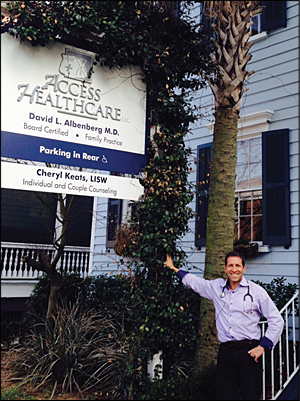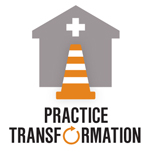
This practice cured its insurance headaches by switching to a cash-only payment model and charging annual retainer fees.
Fam Pract Manag. 2014;21(3):10-15
Author disclosure: no relevant financial affiliations disclosed.
With the ever-changing rules and reimbursement restrictions being imposed by Medicare and private payers, many family physicians have embraced “cash-only” and “retainer-based” payment models to bypass insurers entirely.
These models, which include “direct primary care,” “direct pay,” “concierge,” and other subtly different forms, are collectively seen as a way for physicians to focus more tightly on patient care while normalizing reimbursement.
David Albenberg, MD, has operated Access Healthcare LLC for more than a decade, serving around 350 patients in Charleston and Mount Pleasant, S.C., in his retainer-based practice.
He didn't anticipate operating this type of practice when he walked out of his Charleston-based independent practice association (IPA) in 2002, turning his back on five years of traditional medical practice. He simply had a goal of never dealing with insurance again after becoming frustrated by the pressures and dictates of payers, including having to see 30 to 35 patients a day, feeling his care was compromised because of the rush, and not understanding the financial rules under which he worked.
But he said the retainer model made more sense if he considered it as just another capitated system. He has used it to dramatically transform his practice, which allows him to spend more time with his patients and concentrate on their care, improve his work-life balance, increase revenue, and generally restore his joy of practice.
“The biggest step was coming to an emotional point of understanding and enlightenment that this (traditional model) was not working,” Albenberg said. “After that, it's sort of ‘Build it and they will come.’”

How does it work?
Most retainer-based practices act as a miniature insurance company, charging patients an annual fee that covers a portion or all of their regular medical care, including check-ups, primary care, preventive care, and coordinating care with specialists. Not all retainer-based practices are completely severed from insurers; some work with insurers to pay for portions of a patient's care.
Direct-pay practices that don't use a retainer or where the retainer covers only a portion of the costs may also charge patients fees at the time of service.
Concierge plans also use retainers but are frequently characterized by higher fees designed to significantly limit the size of the patient panel. That gives patients greater access to the physician through longer appointments and expanded office hours or even house calls.
In all cases, not having to bill or negotiate with payers can simplify and add predictability to the financial relationship between patient and physician. It also can reduce staffing needs, bringing down overhead and improving practice profitability.
According to the American Academy of Private Physicians (AAPP), approximately 5,500 physicians in the United States operate with some form of direct financial relationship with their patients, beyond standard insurance. That number has increased around 25 percent a year since 2010, the AAPP said.
In Albenberg's case, he offers patients three tiers of membership:
“Silver” members pay $100 a month, and this plan is aimed at patients looking to supplement their traditional insurance plans. They receive access to all services available during office hours, including check-ups, chronic care management, and simple office procedures (e.g., removing skin tags, sewing up lacerations, treating sinusitis, and running EKGs) at no additional charge. While these services are similar to what the patient would receive at a traditional practice, Albenberg sells the value of greater attention and access.
“Gold” members pay $150 a month, and this level is meant for patients with no insurance or a high-deductible policy tied to a health savings account. In addition to the silver-level services, this tier's patients receive an allowance for laboratory tests or radiology provided by third-party companies and practices.
“Platinum” members pay $200 a month and receive all the services of the first two levels plus 24-hour access. Albenberg will meet patients at the office after-hours or on weekends and occasionally at their homes, if necessary.
“I didn't like the idea of a high-end concierge practice,” he said. “I wanted to set up a tiered pricing system with three different plans so I'd have a better chance of attracting three different types of patients.”
The plan fees are automatically debited from the patient's credit card quarterly or annually, removing virtually any need for a billing and collections operation in the office. Patients who run into financial difficulty can get a six-month reprieve from their fees before being dismissed from the practice, assuming they have been a patient in good standing for at least one year.
The direct-pay practice makes up about 75 percent of Albenberg's income, which is supplemented by a cash-only urgent care operation that serves Charleston's tourism and movie/television production industries and relatives of his retainer-practice patients.
Appointments can last 45 minutes, although most are much shorter, and he keeps his schedule open enough to offer same-day scheduling. He said he also expands his access by providing a lot of care through email, Skype, or texting.
Making the switch
Once Albenberg determined he was going the retainer route, he had to build a business model and practice infrastructure virtually from scratch. While direct-pay and concierge plans are more common today, they were very much in the minority a decade ago and ready-made infrastructure wasn't yet available.
Albenberg's wife, who has an MBA, developed the practice's financial system with Excel, and they jointly built their own practice management software, which is still in use today. He said he's glad he didn't have to create his own billing department like a startup traditional practice would.
Next, he had to do a fair amount of research to determine how much it actually cost to provide services, owing to the fact he had operated for years under insurance pricing. That information allowed him to map out the retainer tiers and the fees for his urgent care operation.
He also recognized early on the importance of having good electronic health record technology, especially if he was going to serve patients after-hours and would need quick remote access to their files.
As challenging as it was to set up the practice, attracting established and new patients proved much harder.
Explaining it to patients
When Albenberg switched to the direct-pay model, he was still offering the same primary care services he had before, but the financial relationship with patients was different. He explained the new system in a letter to his patients. But he said he should have followed that up with a phone call to personally explain how direct-pay and annual retainer models work.
Especially for patients who had insurance, the idea of paying additional money for primary care – despite the improved access and attention – was an obstacle. Albenberg explained to them that he could provide them a simulated bill with all of the diagnosis codes and fees he would have charged had he accepted insurance and they could submit that information to their insurer for out-of-network benefits. He said he doesn't know how many of his patients actually seek reimbursement from insurers.
“I normally get a completely glazed-over look from the patient,” he said. “There are people who are taken back and are so confused by doctors who have simplified things by not taking insurance that, paradoxically, they think what we're doing is shady or complex.”
Albenberg ended up retaining only around 10 percent of his original panel of 3,000 patients, which he said was fewer than what similar practices typically experience. His numbers may have been hampered by three months of inactivity between when he left the IPA and opened Access Healthcare, as well as the fact that he moved off of Charleston's James Island, where the IPA and many of his patients were based.
Referrals from existing patients, on the other hand, have proven to be a great source of new patients because those patients are able to personally explain how the practice works, making the would-be patients more comfortable. Albenberg recommends that direct-pay physicians develop a good “elevator speech” – focusing heavily on greater patient access and care quality – so they can succinctly explain the concept to patients and others on the fly.
Because direct-pay practices are not familiar to most patients and can be complicated to explain, traditional marketing, such as in newspapers or television/radio advertising, proved ineffective for Albenberg.
“I have to say this is an area of intense frustration for me because even 10 years later, while we have a very successful, full practice, we don't have the patient panel that we thought we were going to have,” he said, noting that while many direct-pay practices see older, patients, his panel skews much younger, partly because of his proximity to a college.
To attract older patients and increase overall access, Albenberg opened a second location, in Mount Pleasant, two years into his new practice.
Albenberg said physicians who transition to a direct-payment model must be prepared to lose many of their existing patients.
“In order to change a system, it has to feel uncomfortable,” he said.
TIPS FROM ACCESS HEALTHCARE
Check your motivation. Retainer-based and direct-pay practice is liberating and potentially lucrative. But it's also hard work as you can't rely on insurance plans funneling patients to you. It also requires more focus on the consumer expectations of patients, such as spending more time with them. Simply “tweaking” your traditional practice to not accept insurance may not be successful.
Research prices. The way insurance plans contract for health care services has often disconnected charges from what it actually costs to provide those services. If you're going to operate on your own, you'll need to determine how much to charge patients directly or through retainer fees to ensure profitability. If you go with a national franchise operator, much of this work has already been done for you.
Price for your market. Think like a retailer when determining the size of your retainer fee. The price to attract a limited patient panel of older, more affluent patients is much different from one aimed at attracting young families or college students. You can also use several price points to attract different types of patients.
Stay legal. Some states or local governments place additional regulatory burdens on retainer-based practices. Ask a health care consultant or attorney for help in identifying any that would apply to you.
Inform your patients. Once you've made the decision to change to a direct-pay or retainer-based model, notify patients immediately to begin explaining in detail how the change will affect them. They will especially want to know what services are included under the retainer, how much they'll have to pay for non-covered services, and how you'll help them if they file insurance claims. Be aware that some if not most of your patients may not make the switch with you.
Elevator speech. Attracting new patients will require explaining how retainer-based and direct-pay practices work. Long explanations tend to drive people away, so develop a short “sales pitch” that details the differences from traditional practices while highlighting the additional value to patients in terms of quality and access. If they like the initial description, they'll likely ask you more in-depth questions.
Better profits and practice
With no insurance hassles and limited billing, as well as a smaller patient panel, Access Healthcare has kept its operation streamlined and limited traditional overhead. The Charleston office, which handles 50 to 60 face-to-face patient encounters a week, includes Albenberg, a practice administrator, and a part-time nurse. The Mount Pleasant location includes Jennifer Pullano, DO, and a receptionist.
Albenberg said it's difficult to compare his overhead costs with those of a traditional practice as he continues to spend a significant amount on unusual items, such as paying for patients' radiology scans through the gold and platinum tier allowances, sending onesies to patients with newborns, rewarding referrals with flowers, and getting the word out about the urgent care service to area hotels, marinas, and movie sets.
He also has had to invest in technology, leading to a paperless office and greater patient accessibility. A digital vital sign monitor measures patients' vitals upon their arrival for appointments and immediately sends the results to the patient's electronic health record. This reduces wait times, and the lack of billing speeds up check-out time.
Still, the smaller operation and steady stream of dedicated patients has led to Albenberg generating a salary that he estimates is twice as much as that of a traditional family physician. Having a more predictable and less stressful practice is an even bigger benefit, though, especially for his family.
The direct-pay model also has strengthened his bond with his patients who no longer see him as an extension of their insurance plans.
“My patients are often sheepish about calling me after hours because they know I have a life, but I always encourage them to do so,” he said. “It's very different from a practice where the patient has no accountability toward the provider. They're just another number. They're treated as one, so that's how they're going to treat the doctor back.”
That said, he warned that the greater patient accessibility can cut both ways with some patients having unreasonably high expectations, texting, and emailing him at all hours for lab results or prescription refills, even though he has an online portal that can provide a lot of those services.
“When you have a relationship in this model, which is what I have with my 350 patients, there's definitely an opportunity for abuse,” he said.

Pro tip: Check your motivation
Albenberg has some other notes of caution for physicians looking to transform into a retainer-based practice. One is to get professional help developing a business plan that reflects the realities of your local market.
Setting up a direct-pay practice requires a “consumer first” mindset. For instance, if patients in your old practice complain about having to sit 45 minutes in the waiting room before their visit or wish they could see you in the evenings or on weekends when they're not working, that's an unmet consumer demand that may be an important piece of your new business plan.
Physicians who are looking to merely “tweak” their relationship with patients or payers or who are pursuing direct-pay merely as a way to increase income or improve their lifestyle are likely to fail, says Albenberg, because they aren't likely to respond to their consumers adequately.
Above all, physicians in direct-pay practices must communicate to their patients the value they represent in terms of added access, longer appointments, and closer communication, Albenberg said. If the physician expresses confidence that he or she is worth more than a $20 copay, the patient is more likely to agree.
ABOUT THIS SERIES
Many physicians spend time tweaking the operation of their medical practices, looking for shortcuts and add-ons that may boost productivity and profitability, lower costs, or improve quality.

But what about practice transformation, the act of dramatically changing the way a practice operates, presents itself to patients, and plans for the future? In this and previous issues, Family Practice Management has profiled several of these practices, showing what problems they faced, what changes they made, and how that transformation benefitted them in the end.
Articles include:
“Practice Transformation: Taking the Direct Primary Care Route,” FPM, May/June 2014.
“Practice Transformation: Lessons From a Safety Net Clinic,” FPM, March/April 2014.
“Practice Transformation: Running Your Business Like a Business,” FPM, September/October 2013.
